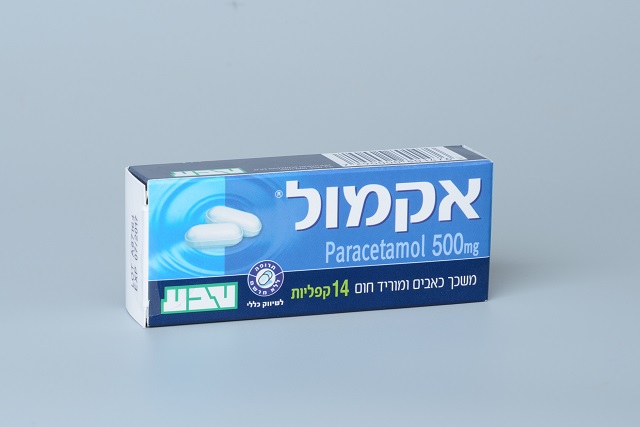Quest for the right Drug

אקמול ACAMOL (PARACETAMOL)
תרופה במרשם
תרופה בסל
נרקוטיקה
ציטוטוקסיקה
צורת מתן:
פומי : PER OS
צורת מינון:
קפליות : CAPLETS
עלון לרופא
מינוניםPosology התוויות
Indications תופעות לוואי
Adverse reactions התוויות נגד
Contraindications אינטראקציות
Interactions מינון יתר
Overdose הריון/הנקה
Pregnancy & Lactation אוכלוסיות מיוחדות
Special populations תכונות פרמקולוגיות
Pharmacological properties מידע רוקחי
Pharmaceutical particulars אזהרת שימוש
Special Warning עלון לרופא
Physicians Leaflet
Adverse reactions : תופעות לוואי
Adverse Reactions Adverse reactions of paracetamol are rare and usually mild. Hepatotoxicity: see Warnings. Hematologic: neutropenia and thrombocytopenia purpura have been reported and rarely agranulocytosis. Hypersensitivity: reactions including skin eruptions, laryngeal edema, bronchospasm, and/or anaphylaxis have occurred rarely. Dose-dependent cross-sensitivity to paracetamol may occur in aspirin-sensitive asthmatics. Low initial doses of paracetamol (less than 1000 mg) are recommended in these patients, with monitoring for about 3 hours following initial doses. Renal: nephropathy, including papillary renal failure has been reported following consumption of large amounts of paracetamol. Renal tubular necrosis has been associated occasionally with hepatic injury produced by paracetamol overdose. Precautions If a sensitivity reaction occurs, discontinue use. Paracetamol should be given with care to patients with impaired kidney or liver function. Risk-benefit ratio should be taken into consideration in the presence of viral hepatitis and alcoholism, since there is an increased risk of hepatotoxicity. Drug Interactions Paracetamol/Oral Anticoagulants: Regular administration of paracetamol may enhance the activity of coumarin anticoagulants when given concurrently. Occasional doses have no significant effect. Paracetamol/Hepatic Enzyme-Inducing Agents (e.g., Barbiturates, Carbamazepine, Phenytoin)/ Hepatotoxic Medications/Alcohol: Concurrent administration of enzyme inducers and paracetamol may decrease the therapeutic effect of paracetamol, probably because of increased metabolism resulting from induction of hepatic microsomal enzyme activity. The risk of hepatotoxicity with single toxic doses or prolonged use of high doses of paracetamol may be increased in patients consuming alcoholic beverages or in patients taking other hepatotoxic medications. Paracetamol/ Salicylates/ Other Non-Steroidal Anti-Inflammatory Drugs (NSAIDs): Chronic high-dose administration of paracetamol with salicylates and/or other non- steroidal anti-inflammatory drugs increases the risk of analgesic nephropathy. Acamol TC, 9. 4. 2008, RH Paracetamol/Zidovudine: Paracetamol may competitively inhibit the hepatic glucuronidation and decrease the clearance of zidovudine. Zidovudine may also inhibit the hepatic glucuronidation of paracetamol. Concurrent use should be avoided, because the toxicity of either or both medications may be potentiated. Paracetamol/Cholestyramine: Cholestyramine may reduce the absorption of paracetamol. Oral doses of cholestyramine and paracetamol should be given at least 1 hour apart. Paracetamol/Metoclopramide/Domperidone: The speed of absorption of paracetamol may be increased by metoclopramide or domperidone. Diagnostic Interference Blood Glucose Determinations May be falsely decreased when measured by the glucose oxidase/ peroxidase method, but probably not when measured by the hexokinase/ glucose-6-phosphate dehydrogenase (G6PD) method. Serum Uric Acid Determinations Falsely increased values may occur when the phosphotungstate uric acid test method is used. Urine 5-hydroxyindoleacetic Acid (5-HIAA) Determinations Qualitative screening tests using nitrosonaphthol reagent may produce false- positive test results. The quantitative test is unaffected. Pancreatic Function Test Using Bentiromide Administration of paracetamol prior to the bentiromide test will invalidate the test results, because paracetamol is also metabolized to an arylamine and will therefore increase the apparent quantity of para-aminobenzoic acid (PABA) recovered. It is recommended that paracetamol be discontinued at least 3 days prior to administration of bentiromide. Dosage and Administration Adults 1-2 tablets or caplets every 4-6 hours, as required. Do not exceed 8 tablets or caplets per day. Children 6-12 Years of Age ½-1 tablet every 4-6 hours, as required. The child should not receive more than 5 doses during 24 hours.

שימוש לפי פנקס קופ''ח כללית 1994
Mild to moderate pain, antipyretic
תאריך הכללה מקורי בסל
01/01/1995
הגבלות
תרופה שאושרה לשימוש כללי בקופ'ח
רישום
128 74 25337 05
מחיר
0 ₪
מידע נוסף
